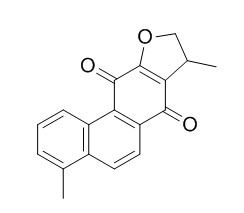Dihydroisotanshinone I
Dihydroisotanshinone I has protective action against menadione-induced hepatotoxicity, attributed to its antioxidant properties including the free radical scavenging activity and inhibition of lipid peroxidation.
Inquire / Order:
manager@chemfaces.com
Technical Inquiries:
service@chemfaces.com
Tel:
+86-27-84237783
Fax:
+86-27-84254680
Address:
1 Building, No. 83, CheCheng Rd., Wuhan Economic and Technological Development Zone, Wuhan, Hubei 430056, PRC
Providing storage is as stated on the product vial and the vial is kept tightly sealed, the product can be stored for up to
24 months(2-8C).
Wherever possible, you should prepare and use solutions on the same day. However, if you need to make up stock solutions in advance, we recommend that you store the solution as aliquots in tightly sealed vials at -20C. Generally, these will be useable for up to two weeks. Before use, and prior to opening the vial we recommend that you allow your product to equilibrate to room temperature for at least 1 hour.
Need more advice on solubility, usage and handling? Please email to: service@chemfaces.com
The packaging of the product may have turned upside down during transportation, resulting in the natural compounds adhering to the neck or cap of the vial. take the vial out of its packaging and gently shake to let the compounds fall to the bottom of the vial. for liquid products, centrifuge at 200-500 RPM to gather the liquid at the bottom of the vial. try to avoid loss or contamination during handling.
Cardiovasc Toxicol.2021, 21(11):947-963.
J Food Sci Technol.2022, 59(1):212-219.
Srinagarind Medical Journal2017, 32(1)
J of Essential Oil Research2019, 1677272
Industrial Food Engineering2015, 19(4):408-413
Natural Product Sciences2024, 30(1):8-13.
Pharmacol Rep.2022, 74(1):175-188.
J Nat Sc Biol Med2019, 10(2):149-156
J Mass Spectrom.2022, 57(2):e4810.
University of East Anglia2023, 93969.
Related and Featured Products
Planta Med. 2002 Dec;68(12):1077-81.
Dihydroisotanshinone I protects against menadione-induced toxicity in a primary culture of rat hepatocytes.[Pubmed:
12494333]
Dihydroisotanshinone I is a phenanthrenequinone derivative isolated from the roots of Salvia trijuga Diels.
METHODS AND RESULTS:
The present study demonstrated the hepatoprotective effect of Dihydroisotanshinone I against menadione-induced cytotoxicity in a primary culture of rat hepatocytes. Pretreating the cells with Dihydroisotanshinone I at concentrations ranging from 2.5 microM to 20 microM for 24 hours caused dose-dependent protection against hepatotoxicity induced by menadione. Intracellular glutathione level and activity of DT-diaphorase have been suggested to play important roles in menadione-induced cytotoxicity. However, treating the hepatocytes with 20 microM Dihydroisotanshinone I for 24 hours did not cause a significant change in glutathione level and DT-diaphorase activity. On the contrary, adding Dihydroisotanshinone I to freshly isolated hepatocytes at concentrations between 50 nM to 200 nM inhibited NADH-induced superoxide production dose-dependently as indicated by the decrease of lucigenin-amplified chemiluminescence. In addition, Dihydroisotanshinone I at concentrations ranging from 5 microM to 20 microM inhibited tert-butyl hydroperoxide-induced lipid peroxidation dose-dependently in isolated hepatocytes as indicated by the level of malondialdehyde.
CONCLUSIONS:
These results suggest that the protective action of Dihydroisotanshinone I against menadione-induced hepatotoxicity is attributed to its antioxidant properties including the free radical scavenging activity and inhibition of lipid peroxidation.
Eur J Pharmacol. 2006 Sep 28;546(1-3):28-35.
Activation of the iberiotoxin-sensitive BKCa channels by salvianolic acid B of the porcine coronary artery smooth muscle cells.[Pubmed:
16928370]
METHODS AND RESULTS:
In this study, we examined the effects of Salvia miltiorrhiza (Danshen) crude extract, some of its lipid-soluble components (tanshinone I, tanshinone II(A), cryptotanshinone, Dihydroisotanshinone I) and the water-soluble compounds (danshensu and salvianolic acid B) on the K(+) channels such as the iberiotoxin-sensitive Ca(2+)-activated K(+) (BK(Ca)) channels and the glibenclamide-sensitive ATP-dependent K(+) (IK(ATP)) channels of the porcine left anterior descending coronary artery smooth muscle cells. Cumulative application of salvianolic acid B (30-300 microM) caused a l-NNA (100 microM)-insensitive, potentiation of the outward BK(Ca) current amplitude with no apparent effect on the IK(ATP) channels opening. Salvianolic acid B (300 microM) caused an ODQ (10 microM, a guanylate cyclase inhibitor)-sensitive enhancement of the outward BK(Ca) current amplitude. In contrast, none of the other isolated chemical constituents of S. miltiorrhiza modified the openings of the two types of K(+) channels studied.
CONCLUSIONS:
In conclusion, our results suggest that salvianolic acid B, a major hydrophilic constituent found in Radix S. miltiorrhiza, activated the opening of the BK(Ca) channels of the porcine coronary artery smooth muscle cells through the activation of guanylate cyclase without the involvement of the nitric oxide synthase activation.



